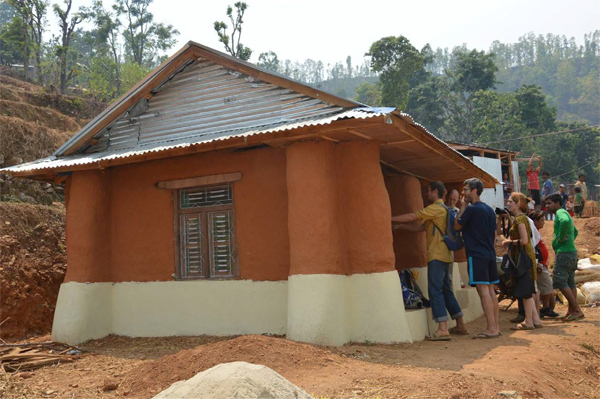
I’m back home now (yeah!), but wanted to share more of what we saw while touring earthbag projects near Kathmandu. Carisimo, a German-based NGO, have built 30 earthbag houses in this village using young foreign volunteers and local families. This is the largest earthbag housing project in Nepal that we know of.
Mulabari is high in the mountains on a steep, terraced slope several hours west of Kathmandu. Each house measures 9 x 13 feet interior. That’s small by Western standards, but the houses felt very cozy and comfortable inside. The earthbag walls were built in 7-10 days each. Families worked in groups of 10 to build each others’ houses, and over time the groups were building their houses unsupervised. We watched the workers (primarily women) lay the earthbag tubing on one wall in about five minutes. This doesn’t include the time to fill the buckets with soil, but still it shows how fast earthbag building can be particularly when using polypropylene tubes instead of bags. Tubes are faster, easier, less expensive and readily available in Kathmandu in giant rolls.
The most interesting thing was seeing the evolution of the houses over the last 8 months during our 3 hour tour. Each house on the tour was stronger and better built than the previous ones. There are massive earthbag buttresses on every corner (which make it easy to add new rooms later), and buttresses near the door (the weakest area). One house even included a second story made of lightweight framing and corrugated metal siding, plus wrap-around porches that mimics traditional Nepali style. The core earthbag portion was identical to the others. This goes to show how small, simple houses can be expanded over time both upward and outward. One house has a curved wall to demonstrate how families can create their own adaptations.
The workers did an outstanding job of building safe, cozy, durable and attractive houses on a very tight budget of $900 per house. However, the limited funding meant taking several shortcuts to reduce costs. The main problem at Mulabari was hiring a tour guide with no construction experience as the supervisor. Carisimo has since partnered with Good Earth Nepal in another village to continue building earthbag houses with more professional and reliable site management. Carisimo also agreed to a higher budget to upgrade the design and pay for a professional site supervisor and site evaluations by an engineer. These added measures will go a long way to build stronger, more durable houses that will reduce risk for everyone concerned.

WOW~WOW~WOW!
YES i would love to be part of a team helping to build my own home and other folks’ homes like these.
The volunteers in Nepal are amazing. Very talented, hard working, kind hearted, etc.
So what do you think? Would you buy one for $1,000? The upgraded model with all the recommended earthquake resistant features is around $2,600.
Hi Owen,
I would be very interesting in hearing more about the earthquake resistant features. I am looking to build using earthbags around the Bellingham, Washington area and would love to use your Zero Energy Four model plans. Bellingham is, of course, in a very earthquake prone area (ring of fire). Would you have or know of any resources that specifically address building with earthbags for earthquake areas?
Do you think the Precision Structural Engineering group that you recommend could certify Zero Energy Four plans to turn in to the local permitting authorities for a building permit?
All you need to do is hire Precision Structural Engineering. They can turn my basic plans into full blown engineered plans that will get code approval. What they do in Nepal is really not relevant to your situation.
Thanks Owen!
This is one of the most fortunate villages in Nepal. 99% of victim families in Nepal have received little or no help — mostly gov hot air empty promises. A big shout out to Lucas, Eva, Justin and the other volunteers, and to Carisimo who made this amazing project possible.